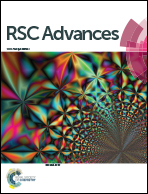Correlation of montmorillonite exfoliation with interlayer cations in the preparation of two-dimensional nanosheets
Abstract
Montmorillonite (MMT) could be easily exfoliated into two-dimensional (2D) MMT nanosheets, leading to potential applications in many fields. In this work, the varying exfoliation properties of Na– and Ca–MMTs were investigated through atomic force microscopy (AFM) and molecular dynamics simulation for energy calculation in order to understand the effect of interlayer cations on the preparation of 2D MMT nanosheets. AFM results showed direct evidence that Na–MMT is easier to be exfoliated than Ca–MMT in the 2D nanosheet preparation. This observation was due to Ca–MMT having a higher interlayer binding energy (IBE) than Na–MMT because of the charge effect of the cations. Besides, the interaction energy between the water layer and two MMT layers (EW–M) of Na–MMTs was lower than that of Ca–MMTs at the same water content. In addition, it was found the exfoliated Ca–MMT had a larger particle diameter than that of exfoliated Na–MMT. These findings might be helpful for the preparation and application of 2D MMT nanosheets through controlling the exfoliation of MMT.



 Please wait while we load your content...
Please wait while we load your content...